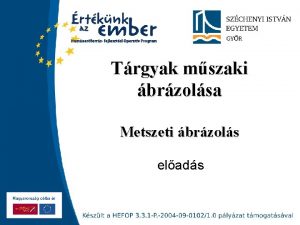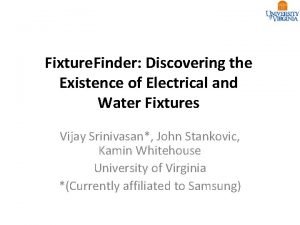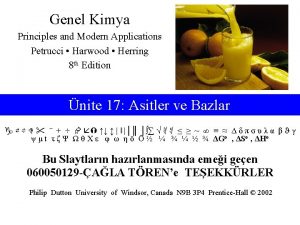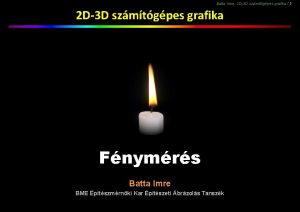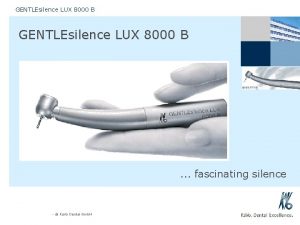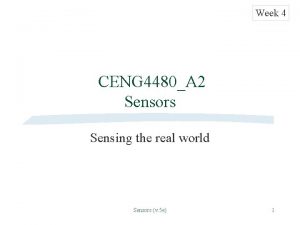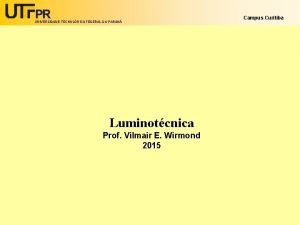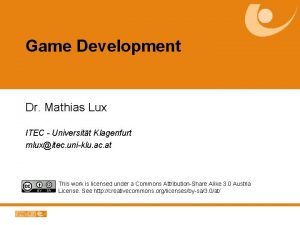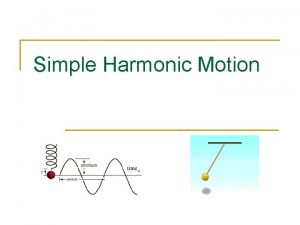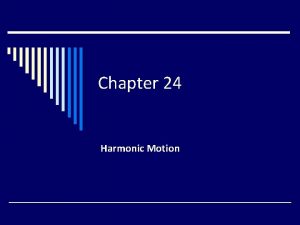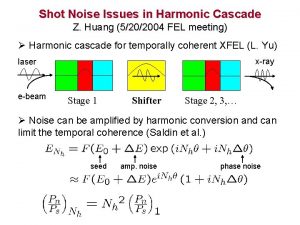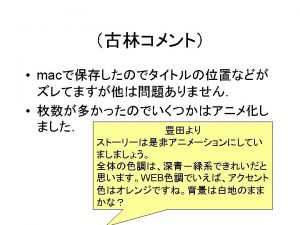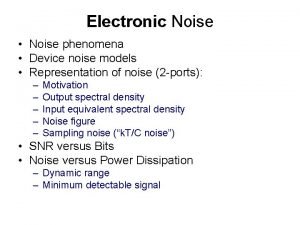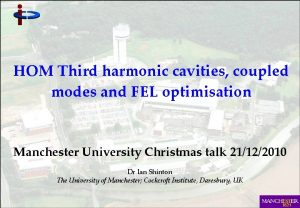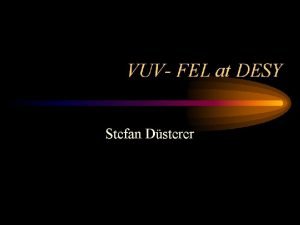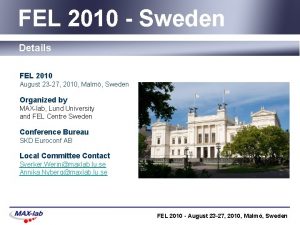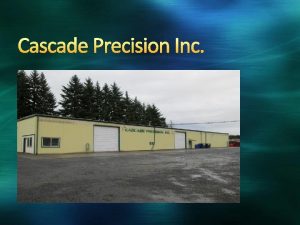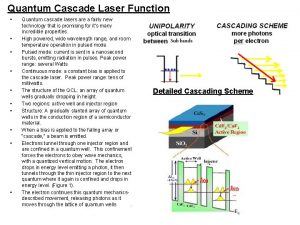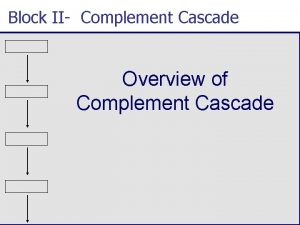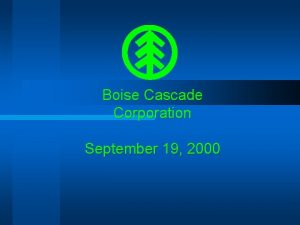LUX Harmonic Cascade FEL and Noise Evolution William






















- Slides: 22

LUX Harmonic Cascade FEL and Noise Evolution William M. Fawley Lawrence Berkeley National Laboratory Presentation to LCLS Theory Meeting 20 May 2004, adapted from LUX Machine Technical Review Panel presentation, April 2003

Basic Principle of a Harmonic Cascade 1) Energy-modulate e-beam in undulator via FEL resonance with coherent input radiation Input Output energy -p phase 2) With dispersive section, strongly increase bunching at fundamental wavelength and (non-linearly) at higher harmonics 4 a) In standard HGHG scheme (L. H. Yu) , long radiator undulator strong exponential gain, perhaps saturation p 3) In new undulator resonant at l 0/n, bunched beam strongly radiates harmonic radiation via coherent spontaneous emission (CSE) -np np 4 b) In “Low Gain” HG scheme, CSE radiation sufficient without further amplification to produce strong energy modulation in next cascade stage -np np radiator modulator delay chicane

LUX provides tunable, ultrafast x-ray pulses from ps electron bunches • Soft x-rays • “HGHG” • Laser-seeded cascaded harmonicgeneration in FEL’s • Strong modulation • Low-gain FEL – 20 -1000 e. V – Spatial and temporal coherence – 10 -100 fs – 10’s - 100’s MW • Hard x-rays • Spontaneous emission in narrowgap short-period insertion devices – 1 -12 ke. V – 50 -100 fs

Why a Harmonic Cascade FEL for LUX? • Recirculator e-beam with low emittance, low energy spread, relatively high current permits: short gain lengths & short undulators efficient bunching modulation very strong coherent spontaneous emission (CSE) from pre-bunched beams • Recirculation configuration for LUX accelerator permits – Accurate timing & synchronization – Staged use of different temporal e- beam portions in different undulators • Moderate Ge. V e- energies permit: – FEL resonance from far UV to soft-xray wavelengths – Cascade initiation with moderate power, coherent radiation seed in 200 -nm region

Comparison of Harmonic Cascade FEL to SASE FEL “Standard” SASE FEL • Emission easily wavelengthtuned but usually strong at only one l • Simple undulator config. • Noise initiation, finite slippage limits longitudinal coherence • Relatively large shot-to-shot power fluctuations Harmonic Cascade FEL • Simultaneous emission at multiple l but more complicated undulator tuning • Complicated undulator config. • Longitudinal coherence determined by input seed • Shot-to-shot fluctuations controlled by input seed, e-beam • Very short pulses, inherent • Difficult to shorten pulse t & pump-probe synchronization possible synchronize for pump-probe • Output power can be strongly • “Low-gain”, harmonic generation approach appears dependent upon emittance, to reduce output sensitivity energy spread, current to seed power, beam current

LUX Harmonic Cascade Design 200 -fs seed pulse from “master oscillator” laser Position of FEL pulse in full electron beam pulse radiator head tail High quality e- pulse Low e (2 p mm-mrad) Moderate I (500 A) Low s. E ( 200 ke. V) Master oscillator pulse Tbunch >> TMO PMO ~ 1 GW > modulator 105 Pshot Unperturbed electrons s. E ~ s. E (0) Delay-producing micro-orbit-bump (~250 fs) 3 rd - 5 th FEL modulator harmonic LW < LSAT radiator Strong bunching Pout ~ 0. 3 PMO b 1 ~ 0. 25 bn ~ 0. 01 3 rd - 5 th 3 - 5 th harmonic FEL modulator / radiator low gain amplifier Pout ~ 0. 1 PMO LW < LSAT

2508 At each modulator, radiation interacts 0. 4 GW with “virgin” e. At each harmonic upshift l l/n (modulator to radiator), macroparticle phase multiplied by n 240 -nm modulator P(z) Z (m) 48 -nm radiator Z (m) 0. 4 GW Bunching effects of dispersive section visible in change from Z=6 m in 48 - 120 nm modulator to Z=0. 4 m scatter plot in 12 -nm radiator GINGER LUX simulations Energy (Me. V) Power vs. Z & 1. 0 GW g-q scatter plots 2492 -p 2510 3. 6 2490 4. 4 -5 p 2504 MW Z=1. 8 m q (radians) Z=2. 4 m Z=0 m q (radians) 2496 6. 0 -p 2504 Z=3. 6 m +p Z=4. 4 m +5 p Z=3 m Z=0 m 48 --nm nm 48 modulator Z (m) Z=0 m Z=6 m +p q (radians) 12 -nm radiator Z (m) 2496 -4 p 5. 4 Z=0. 4 m q (radians) +4 p Z=3. 4 m Z=5. 4 m

Some Noise Effects in a Cascade • Noise growth can/will limit longitudinal coherence • Known noise sources and phenomena: – Amplitude and phase noise on laser seed – E-beam parameter variations (e. g. current, energy, emittance) output phase & amplitude variation (generally slow) – Shot noise on e-beam at each modulator stage; “randomly” additive to input radiation noise • Harmonic up-conversion by factor n in radiator stages simultaneously multiplies phase noise on bunched e-beam by factor n (non-random process!) – known problem in radio tubes • Compared to the “usual” HGHG approach, LGHG scheme decreases coupling of shot noise from one stage to next • Slippage acts as a temporal, low pass filter – can strongly damp laser seed noise in first two cascade stages • Decreasing slippage in later stages long wavelength temporal noise “freezes out” longitudinal decoherence appears as a wandering “chirp”, not as abrupt phase or amplitude jumps

Simulation Results Concerning Noise Evolution from Imperfect M. O. Seed “Standard” LUX 4 -stage cascade configuration (240 nm 1 nm) Fields resolved in simulation on 240 nm/c temporal resolution or better Results: • Noise reaches minimum at 48 -nm radiator stage • In later stages noise increases due to harmonic multiplication of low frequency components d. F(t)/dt (A. U. ) Input laser seed initialized with broadband (a) phase noise (b) amplitude noise RMS phase noise d. F(t)/dt after removal of average component (a) (b) EXIT 240 nm 48 nm 12 nm 4 nm 1 nm

Evolution of Seed Phase Noise • GINGER simulation of LUX with initial laser seed rms phase noise of 22 mrad per 240 nm wavelength 0. 027 • Plots show df(t)/dt l/c for modulator outputs at 240, 48, 12, and 4 -nm stages for radiation (yellow) and e-beam microbunching (blue) 0. 0004 0. 0005 240 nm Time 48 nm 77 fs 0. 0004 • Results show obvious damping of high temporal frequency components by slippage (=24 fs in 240 -nm modulator) • Observationally, output phase noise would appear as a time-varying chirp 12 nm 4 nm

Shot Noise Effects • Due to high input power to modulator stages, effects from random e-beam shot noise microbunching appear small – essentially no growth of bunching in absence of seed signal – In presence of coherent seed, shot noise leads to small phase and amplitude time variations – db 2 ½ ~ 8 10 -4 « b – At 4 nm , |d. P| / P ~ 2 10 -4 10 k. W -3 – At 1 nm, |d. P| / P ~ 5 10 • Figure at right is a 1 -nm output spectrum from a GINGER LUX simulation including shot noise effects – Power at fundamental (10 MW) is suppressed (note semilog scale) 10 W – Output noise dominated by low temporal frequency components


Hypothetical FEL layout for LUX 4 -stage (240 -> 1 nm) harmonic cascade 256 - 192 nm MO input pulse 1000 MW @ 200 fs = 0. 2 m. J 4 – 2. 5 nm radiator ~140 MW output @ 5 m = 5 1011 photons / 200 fs 50 - 40 nm radiator 360 MW output @4 m 30 e. V beamline 12 - 10 nm radiator ~100 MW output @ 5 m 1 ke. V beamline 100 e. V beamline 50 - 40 nm FEL modulator (6 m) 256 – 192 nm FEL modulator (3. 6 m) 12 - 10 nm FEL modulator (5 m) 4 – 2. 5 nm FEL modulator (4 m) 300 e. V beamline 1 -nm radiator / amplifier ~10 MW output @ 10 m = 1010 photons / 200 fs Note bends after each modulator & delay chicanes after each radiator stage

Table of FEL Parameters Wavelength lu (cm) Lu (m) au Bu(T) r x 103 Lu / Lgain 240 nm 12 3. 6 9. 7 1. 2 2. 3 0. 87 48 nm 7. 5 1. 1 2. 2 1. 8 12 nm 4. 0 1. 4 1. 1 1. 7 4 nm 3. 0 1. 2 0. 75 1. 4 1 nm 2. 5 0. 6 0. 4* 2. 0 4. 0 / 6. 0 5. 4 Rad / Mod 5. 0 / 5. 0 3. 7 R/M 5. 0 / 4. 0 2. 3 R/M 10. 0 1. 0 * Note: Emittance, energy spread effects neglected in calculation of FEL parameter r and Lgain ; these effects strongly suppress gain at 1 nm

Some Known Risks & Concerns • “Multiplicative” growth of problems from stage to stage in cascade • • Seed laser phase noise E-beam microbunching shot noise Decoherence effects of bends High order effects of chicane optics • Temporally “coherent” sweep of e- beam properties (e. g. emittance, energy, current) • Shot-to-shot repeatability of laser seed, e- beam • How short of an output pulse is possible?

Initial Simulation Code Modeling • Polychromatic, multidimensional (r, z, t) FEL code GINGER used to model sample LUX cascade configuration • Radiation output, e-beam macroparticles passed from one stage to next as appropriate • Highly idealized dispersive sections & chicanes (e. g. Df Dg, pure achromat without higher order dependencies) • No examination of mismatches, undulator errors, misalignments/tilts, bend effects, etc. • Numerical investigations included: – Time-steady (monochromatic) optimization – Time-steady sensitivity to e-beam parameters – Time-dependent (polychromatic) noise and short-pulse effects

GINGER Survey of FEL Cascade Sensitivity to Input Beam Parameters • Sensitivity survey examined time-steady, single parameter deviation from assumed base case parameters • “Compassionate” conservative LUX base parameters adopted: – IB = 500 A (1 n. C @ 2 ps) – E = 2. 5 Ge. V - en = 2 mm-mrad – s. E = 200 ke. V (uniform energy spread) • Simulation results showed: – Relatively small sensitivity to 10% parameter swings – Output at 1 -nm far more sensitive than at 4 -nm – Pulse-to-pulse, mean e-beam energy needs to be repeatable to ~ 0. 05% level or better

4 - and 1 -nm Output Power Sensitivity to Input Electron Beam Parameters Base parameters: 500 Amps 200 ke. V uniform d. E 2. 0 mm-mrad 1. 0 GW input P @240 nm 4 -stage harmonic cascade Time-steady simulations Note: 4 -nm power scaled down 10 X to fit on plots Nominal output power: 138 MW @ 4 nm 11 MW @ 1 nm Current (A) Delta E (Ke. V) ( E - E 0)/ E 0 Norm. Emit. (mm-mrad) Input power (GW)

Post-Modulator Bend Concerns • Post-modulator bend should be energy-dependent only: • Vinokurov (1985) suggested using achromat to overcome debunching problems; experimentally verified at Novosibirsk [ see G. N. Kulipanov et al. , “On Mutual Coherency of Spontaneous Radiation from Two Undulators Separated by Achromatic Bend”, IEEE J. Quantum Elec. , 27 No. 12, pp. 2566 -2568 (1991) ] • Difficulties and sensitivity to errors/higher-order effects will likely increase as wavelength decreases from one cascade stage to next

Limits on Short Pulse Duration • Extremely short output radiation pulses will be useful for many applications • Seeded FEL configuration permits initiation with extremely short (~10 fs) radiation pulse • Output radiation pulse duration can temporally shorten or lengthen from stage-to-stage depending upon slippage effects: – If tp >> ts , pulse will tend to shorten by 2 from one harmonic stage to next – If tp ts , pulse will be lengthened by slippage AND greater input laser intensity will be needed for long-pulse-equivalent bunching at modulator exit

Evolution of Pulse Duration 100 MW Scaled Power • GINGER simulation • Initial seed 2. 5 GW, 5 -fs (RMS) Gaussian • Shot noise included • 4 -nm output: — autocorr. t 1/2 ~7 fs — Inverse bandwidth l / Dl ~ 2000 • 1 -nm output: — autocorr. t 1/2 ~3 fs — Inverse bandwidth l / Dl ~ 3000 -20 0 Time (fs) 20 40 Note: pulses arbitrarily shifted in time

Summary • An ensemble of short-wavelength FEL’s based upon the principle of harmonic cascade is an attractive addition to the core LUX proposal • Good temporal synchronization, high current, low emittance permit low gain, harmonic generation to reach down to 4 -nm (and perhaps 1 -nm) output wavelengths for 2. 5 -Ge. V electron beam energies • A harmonic cascade has many advantages, such as coherent seeding and possible output durations 10 fs, over the standard SASE approach • There are many risks and tricky details to master before one can have solid confidence that a 4 -stage cascade will work as dependably as present day light sources
 Fél nézet fél metszet
Fél nézet fél metszet Tension wave
Tension wave Companding in pcm
Companding in pcm Lux massage
Lux massage Lux express
Lux express Fixturefinder
Fixturefinder Onderwereld eckardt as buitestander langvraag
Onderwereld eckardt as buitestander langvraag Requiem aeternam dona ei domine
Requiem aeternam dona ei domine Cd to lux
Cd to lux Verschil tussen lux en lumen
Verschil tussen lux en lumen Gens gentis declinazione
Gens gentis declinazione Konjuge asit baz
Konjuge asit baz Lumen lux átváltás
Lumen lux átváltás Teori asam basa lux flood
Teori asam basa lux flood Theme of betrayal in farewell love
Theme of betrayal in farewell love Lux 8000
Lux 8000 Define scansion
Define scansion Vr lux
Vr lux Nbr 5413 tabela de lux por ambiente
Nbr 5413 tabela de lux por ambiente Lux express campaign code
Lux express campaign code Be ne lux
Be ne lux Mathias lux
Mathias lux Dr lux coesfeld
Dr lux coesfeld
